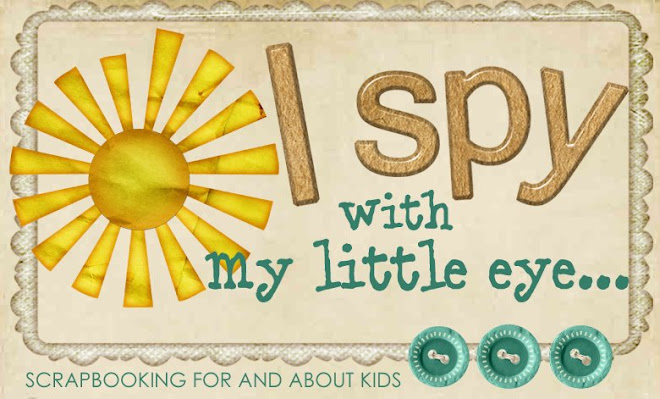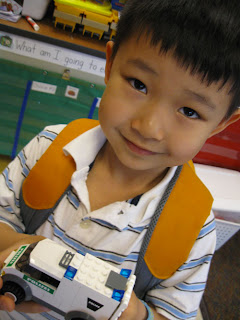Wednesday, May 27, 2009
Money Advice from Kindergarteners...

I definitely wouldn't ask them for any stock tips. (I put the kids' initials in parenthesis if you want to know who said it!)
1. What do we need money for?
- To have a good place to live. (AY)
- For the food that we eat. (AW)
- To buy toys. (OH)
- To buy underwear and clothes. (VR)
- To eat at restaurants. (KDS).
And a very funny conversation between myself and AB:
AB: My mommy pays money to work.
Ms. Warner: No actually, I think it's the other way around. Your mommy gets money for working.
AB: Noooo....
Ms. Warner: Yes.
AB: You mean she gets money for working?
Ms. Warner: Yes.
AB: That doesn't make any sense!
2. Where does money come from?
- The bank?-AB
- They (parents) work and get money. (RK)
- Factories. (CP)
- Dollars come from paper and they just write a number on it and they paint on it some. (BC)
- They use a copying machine. (RK)
3. How much does a car cost?
- 1 dollar and 100 cents. (DY)
- $2 (AS)
4. How much does a computer cost?
- $51 (SH)
5. How much does a Bakugon cost?
- $125 (RI)
- Just about ten bucks. (AB)
6. How much does a Happy Meal cost?
- $35 (EV)
7. How much does a trip top Disney World Cost?
- $150 (AV)
8. You have $1 in your pocket. What could you buy?
- A toy car. (AF)
- A strawberry. (HP)
9. You have $100 in the bank. What could you buy?
- A TV (VR)
Money Makes the World Go 'Round...

We spent our last few days learning about money in math. Kindergarteners are not actually required to learn about money at all, but since we had the extra days and the kids were very interested, so I thought we'd explore it a little. I know that the first grade teachers will appreciate it if we can at least get the kids to know the names of the coins and how much each coin is worth.I also used it as an opportunity to do more problem solving--which is always a good thing.
Here is what we want kindergarteners to understand about problem-solving (from the TEKS and the ARRC):
1.Problems can be found in everyday situations.
2.Models and tools can be used to solve problems.
3.Problems can be solved and explained using various strategies.
Here are a few things you can do to help your child learn about money.

- Really explore the coins. Talk about the images on the front and back--who and what are they?
- Look for the year the coin was made.
- Look for the actual number and words that tell how much the coin in worth.
- Talk about how coins are the same and how they are different. For example, both a nickel and a dime are silver-colored, but a nickel is bigger and thicker.
- Encourage your child to be responsible for his/her own money. Let them keep track of their allowance, and pay for things themselves.
- Start a coin collection. It can be pennies for every year or quarters from every state...

- If your child is ready, have them count coins. Start with pennies and nickels and move on to dimes and quarters only when they are ready. For example--how much money is a dime and 2 pennies? The kids should use any strategy they want to figure this out, i.e. using tally marks to represent the value of each coin and then counting them all together. They don't have to do it all in their heads.

- Have your child use coins to show a certain amount of money (Show me 12 cents.) For an extra challenge, figure out how many ways you can make one amount (i.e. 12 cents can be 12 pennies, 1 dime and 2 pennies, 2 nickels and 2 pennies and so on...)
If your child gets frustrated, stop! Remember--this is not a requirement for kindergarten. Keep it fun!
Saturday, May 16, 2009
Wednesday, May 13, 2009
Ladybug, Ladybug

About 350 ladybugs!
We learned about these beneficial insects as part of our living things unit. We know that:
- Ladybugs are living things.
- Ladybugs have parts that help them live and grow.
- Ladybugs have a predictable life style.
- Ladybugs have basic needs (food, water) and depend on the earth for them.
- Ladybugs are beneficial insects--they help plants by eating harmful insects (aphids).
Like all insects, they have 3 body parts (head, thorax and abdomen) and 6 legs. They use their antennae to feel and smell. They have two sets of wings--hard outer wings that protect their transparent flying wings. Look!
 Here's our giant ladybug. Can you see the transparent flying wings?
Here's our giant ladybug. Can you see the transparent flying wings?

We made our own ladybugs. They have 6 legs, 2 antennae and 2 sets of wings!

Ladybugs have a predictable lifecycle. First, the adult female ladybugs lays her eggs.

A ladybug larva hatches out of an egg, hungry and looking for aphids to eat. It eats and grows and eats and grows. When it gets too big, its skin splits. This happens several times.

When the larva is big enough, it sheds its skin one last time, revealing a pupa. Inside the pupa, the larva is changing into an adult ladybug.

After a few days, an adult ladybug emerges. It is pale and its wings are wet and soft. It doesn't have any spots!

Eventually, the ladybug's wings harden, and it gets its spots. Now, the life cycle can begin all over again!

We used colored beads to make ladybug life cycle bracelets. Have your child use the bracelet to tell you all about the ladybug life cycle.

We know that ladybugs eat aphids. Lots of aphids! An adult ladybug can eat 40-60 aphids a day!
Our ladybugs were very lucky! Our PEWE teacher, Ms. Spitzer, has an aphid problem in her garden, so she brought us milkweed with lots of aphids! We got to see ladybugs eating their tasty snack up close! We wrote about our observations in our science notebooks. Eventually, we took our ladybugs outside and let them go, so they could fly away home.
Eventually, we took our ladybugs outside and let them go, so they could fly away home. 

Thursday, May 7, 2009
The Farm is Back On...
Fractions

Students will recognize that there are quantities less than a whole. They will share a whole by separating it into two equal parts. They will explain why a given part is one-half of the whole. Students will display math concepts using concrete models in problem solving situations connected to everyday experiences.
2. How can you tell that the parts are equal?
3. How can you separate a whole into two equal parts?
4. Why is each part a half?
The Plants Keep Growing....
We Love Lilly!

- Compare/Contrast 2 or more characters from the books.
- Compare the plots from 2 or more books.
- Have your child relate one of the books to his/her own life... "Has that ever happened to you?"
- Ask your child if he/she would have handled the problem the same way.
For more information on Kevin henkes and his books, visit his website (there are no "games," but lots of fun printable activities!)-
Writers...Hard at Work
 Now we need to take it a step further. We are beginning to learn new ways to organize our writing and ways to make our writing more descriptive. So next week, we are going to write about our favorite toys. Please have your child bring in one toy that they love. Please make it small enough to fit in their backpack, and do not send anything electronic or expensive--like Nintendos or PlayStations...We will bring the toys home after a few days. Thanks!
Now we need to take it a step further. We are beginning to learn new ways to organize our writing and ways to make our writing more descriptive. So next week, we are going to write about our favorite toys. Please have your child bring in one toy that they love. Please make it small enough to fit in their backpack, and do not send anything electronic or expensive--like Nintendos or PlayStations...We will bring the toys home after a few days. Thanks!





















